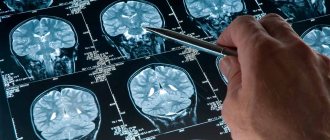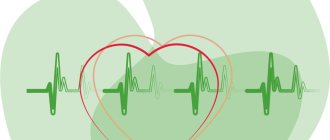Translated from ancient Greek, the term means “split of the mind” or split of the mind,” one might say insanity. But it would be more correct to say “split personality”. Also in early psychiatry, schizophrenic disorder was also referred to as dementia (“dementia praecox”) or schizophrenia. The condition is an endogenous (caused by internal factors) polymorphic disorder of the human psyche, accompanied by the destruction of thinking processes and emotional reactions.
This disorder is characterized primarily by destruction of thinking and perception of reality, which becomes inadequate.
Causes of the disease:
According to modern clinical research, schizophrenia is genetic, that is, it is inherited. However, other theories are also being considered to explain its occurrence:
Neurotransmitter theory
She studies how medications used for treatment, which are collectively called “antipsychotics,” affect patients. This theory includes 3 basic hypotheses:
- Dopamine According to it, the main trigger for the appearance of the disorder is an increased level of the hormone dopamine in the patient. Traditionally, the hormone dopamine has a stimulating effect on the nervous system of a healthy person, but its excess can lead to hyperstimulation of brain activity, which leads to improper functioning of neurons.
- Serotoninova In this case, the cause of the disease is disturbances in the transmission of serotonin through neurons. Receptors begin to work excessively, which ultimately leads to the depletion of certain brain functions.
- Noradrenergic Suggests that the manifestation of schizophrenic symptoms is primarily influenced by the process of decay of neurons that make up the noradrenergic system.
Dysontogenetic theory
Also called the “brain development disorder” theory . Thanks to research, it was found that schizphorenics have constitutional changes in the structure of the brain. It is worth noting that these anomalies are not extensive, so the pathological changes do not progress.
However, in the presence of a stressful or other traumatic factor, the patient may experience decompensation of these structural abnormalities, provoking the development of a mental disorder.
The theory also suggests that the cause of deviations may be complex internal infections, a toxic environment or genetic destruction.
Psychoanalytic theory
It is logical to note that the founder of this approach is Sigmund Freud. He assumed that the disease occurs in people who are closely dependent on the ego, and the origins of such attempts come from childhood. Traumatic situations in childhood and adolescence (cold attitude of parents towards their child) can also be the cause of narcissism and egocentrism, and the symptoms of schizophrenic disorder, including destruction of thinking and delusions of persecution, are their direct consequences.
Genetic theory (constitutional and genetic predisposition)
Some time ago it was believed that schizophrenia, as a disease, has only genetic prerequisites, that is, it is transmitted exclusively by inheritance. There is a significant grain of truth in this conclusion, since the presence of a similar diagnosis in close relatives significantly increases the chances of its development in descendants. Now it is believed that it is not the disease itself that is inherited, but only a predisposition to a number of mental illnesses (alcoholism, epilepsy, suicide, and, in particular), but it can manifest itself or not, depending on the environmental factors in which a person grows.
Theory of internal intoxication (autointoxication and autoimmunization)
It implies that the cause of the development of the disease may be a violation of protein metabolism in the body, and, accordingly, internal poisoning with toxic products that appear as a result of a violation of this metabolism. For example, ammonia, phenol and cresols. Accumulating in the body, they inhibit the correct course of basic processes, which leads to metabolic disorders, the impossibility of timely restoration of the nervous system, and, accordingly, to neurodynamic disorders in schizophrenia.
Cognitive theory
Refers to a cluster of biological hypotheses that consider a biological factor as the fundamental cause that is the trigger in the development of the disease. It is this theory that pays special attention to the study of hallucinogenic symptoms in a patient, which lead to a distorted perception of existing reality.
Infectious theory of genesis of schizophrenia
It assumes the development of the disease as a result of a combination of chronic and acute (usually conditionally pathogenic) infection and, accordingly, inhibition of protective immunobiological mechanisms.
In simpler terms, the reasons can be described as:
- heredity;
- perinatal period (disorders of fetal development in utero);
- destructive social environment (urbanization, low standard of living);
- psychotrauma received in early childhood;
- unfavorable environment;
- brain injury (considered perinatal or early natal periods);
- chemical dependencies (alcoholism, drug addiction);
- any severe stress, anxiety and shock.
Symptoms and signs of schizophrenia
It is quite difficult to determine this disease on your own. Simply the presence of a neurotic state, even if accompanied by pre-hallucinations and delusions, is not yet a stable sign of schizophrenia. The disorder can only be determined by a specialist using special tests. However, there is a primary set of “outpost symptoms” that help identify deviations in the early stages. These symptoms can appear in a person a certain time before the development of the disease itself.
So, early symptoms of schizophrenia:
In most cases, there is a change in hygiene habits (a person becomes unkempt, stops taking care of himself), indifference to the opinions of others appears, social maladaptation of the individual is observed, as well as aggression, inappropriate emotions, unreasonable suspicion, changes in facial expressions, sleep disorders, problems with attention and concentration, disorganized speech, prodromal phenomena, such as a narrowing of the range of interests, changes in personality traits, a person’s feeling that his self has changed, sometimes a decrease in intellectual abilities (a decrease in the motivational factor and volitional component). Bipolar affective disorder very often serves as a harbinger of the development of schizophrenic disorder.
Ambivalence, when the patient simultaneously experiences two opposing feelings or emotions, can also be called a bad symptom. Now he loves, and a few minutes later he hates it; yesterday he liked ice cream, for example, but the next day he didn’t, and so on.
In some cases, on the contrary, the acquisition of certain oddities in behavior is observed: strange hobbies and extremely valuable ideas appear.
General symptoms of schizophrenia
Signs of schizophrenia:
- Violation of logical connections and sequences of actions in social and everyday life. For example, the patient does not take care of his body and personal space because he does not see the point in it.
- Violations of verbal functions and speech saturation. The patient begins to speak very slowly and in monosyllables, and is unable to give a detailed answer to the question.
- A decrease in emotional manifestations, up to their complete absence, expressionless facial expressions, glassy eyes, avoidance of eye contact.
- A sharp drop in concentration level, the patient is unable to concentrate.
- Anhedonia is a complete loss of interest in past hobbies. Considered as an early sign of the disease.
- Affective states. Absolute inadequacy of reactions to various situations. Laughing at someone else's grief or crying for no reason.
Positive symptoms of schizophrenia
- Hallucinosis
It can manifest itself verbally, visually or at the level of sensations.
The patient begins to see, hear or feel phenomena that do not exist in reality. For example, he may look around, listen to non-existent sounds, plug his ears, or talk to someone in an empty room. In the initial stages of the disorder, hallucinations do not appear so often, but as the disease progresses, the condition worsens.
- Obsessive thoughts and ideas
The patient is unable to separate the existing reality from his sick fantasy, which leads to the emergence of destructive thoughts that he is unable to cope with. For example, he may firmly believe that he has a meeting with Napoleon at 15.33. Moreover, he remains absolutely stubborn in his conviction and reacts very aggressively to attempts by those around him to dissuade him.
- Violations of logic and thinking functions
Neural imbalance leads to the inability to think logically and build connections between events, rules or phenomena. Thus, a schizophrenic ceases to understand why, for example, one should not go to a red traffic light or should not sleep on railroad tracks.
- Psychomotor agitation
It manifests itself in mixed, chaotic, sometimes destructive movements, inability to control one’s body, as well as speech function. A person with schizophrenia may break furniture, bang his head against the wall, shout incoherent phrases, and not notice or be aware of the strangeness of his behavior.
- Rave
Clusters of delusions include such conditions as delusions of persecution or delusions of hidden negative influence. In other words, a person believes that he is being affected by some device, waves, radiation or some kind of chemical agent that is sprayed into the air for a harmful purpose. There is also delusion of attitude, when a person thinks that everyone around him is conspiring against him, and he is in the center of some kind of conspiracy, and everyone around him treats him badly, thinks badly of him, his thoughts become known to others, as if broadcast like a radio. Often the patient thinks that he can read other people’s thoughts and knows the content of the selfish plans of others. The person expresses all this uncritically, and it is impossible to convince him otherwise. He is absolutely confident that he is right, which is negative.
Home improvement
After a person is diagnosed with schizophrenia, they will have to rearrange their life a little. First of all, you need to explain to the patient what it is not necessary or even desirable for him to do, for example, turn on the gas or repair the electrical wiring. In the first weeks or months, do not leave him alone and do not let him go outside without an accompanying person. It is unknown who he will meet and how the conversation will go. It is better to keep him busy while walking with a conversation.
A person with schizophrenia may neglect hygiene. At first, you will have to remind him of the need to brush his teeth, shave and take a shower. It is worth considering that this pathology often develops at a young age and often in adolescents. They are not only schizophrenics, but also children, so the usual upbringing continues, but with a number of features described earlier.
In your absence, the patient may leave the apartment without permission. Place notes with phone numbers and addresses in his clothing pockets in case he gets lost. Schizophrenics have problems with short-term memory, so they can simply get lost.
TV viewing will have to be limited. You should not watch horror or thriller films. At the same time, you will have to give them up too. If you forbid them to the patient, but do not limit yourself, he will feel superfluous or defective. It is advisable to give preference to calm programs and films about nature, sports or art.
Alcohol will have to be eliminated from your life. Schizophrenics have a tendency to use psychoactive substances, so it is better not to provoke it and give up alcohol and bad habits yourself. If you serve as a good example for the patient, it will be easier for him to cope with his illness.
Pathogenesis of schizophrenia
Pathogenesis, namely the process of initiation and development of the disease, is quite complex. As was clarified above, the main cause of the disease is due to a genetic factor, which also includes such circumstances as a complicated pregnancy, addictions of one or both parents, psychological or physical traumatic situations during fetal development and in the first months after childbirth. In the future, the development of the disease can be influenced by negative social factors (dysfunctional family, poor care, etc.).
In the case of increased neurotoxicosis (neuronal damage to the brain), degenerative changes in the brain may increase.
So, at the moment, classical psychiatry is studying both exogenous (external) and endogenous (internal) mechanisms that influence the occurrence and development of schizophrenic disorder. Of greatest interest are precisely those hypotheses and theories that consider the results of both clinical and experimental studies at the same time.
Diagnostics
According to statistics, the disease manifests itself most often in adolescence. If there are certain triggers, you can feel the disease at a fairly young age. The onset of schizophrenia is usually observed before the age of 30–35 years.
Prussian psychosis
As noted above, the first symptoms of the disease appear at a young age; schizophrenic disorder does not appear in the second half of life. Acute psychosis in elderly patients is classified in psychiatry as “cyanotic psychosis” rather than schizophrenia. However, its symptoms are quite similar to those of schizophrenia. Hallucinations and delusions may occur. But, most likely, they will be of a vascular nature: vascular dementia, brain destruction (Alzheimer’s, Parkinson’s or Pick’s disease). In any case, such organic brain lesions are not related to schizophrenia. Quite often, the differential diagnosis of schizophrenia causes significant difficulties. This is especially true for the initial stage of the disease or periods of deep remission, as well as when one person combines alcoholism and schizophrenia or has suffered psychotrauma against which pathology has developed. Thus, within the framework of the differential method, it is quite difficult to determine the disease on your own. As noted above, not every symptom characterizes this particular disorder. But a person cannot suspect schizophrenia in himself, since this is associated with a loss of criticism.
He may, for example, discover depression or neurosis and, in connection with them, go to a specialist, who, in turn, should conduct a more detailed study and prescribe medication. But, unfortunately, the disease is often noticed by the patient’s relatives at fairly late stages and they are hospitalized in an acute condition, because advanced symptoms are most often interpreted as coincidences or coincidences, or as a consequence of stress or neurosis. Thus, everyone expects that they will go away on their own, and if they take medications, they are more likely of homeopathic or herbal origin, which do not cure the disease, but simply help to prolong it. Thus, due to incorrect diagnosis and late diagnosis, schizophrenic psychosis most often debuts in the patient in an acute form.
Differential diagnosis of the disorder
An important stage of diagnosis is the differentiation of a schizophrenic attack from a neurotic or other mental disorder, as well as the rejection of diseases of an infectious nature that have a destructive effect on neural connections.
For example, an acute psychosis or manic episode, also identified as a polymorphonic psychotic disorder, can also unfold against the background of other diseases, for example, within the framework of schizoaffective or bipolar disorder, which can serve as precursors, but in general are not related to schizophrenia, since they are to another cluster of diseases, a cluster of mood disorders. Bipolar affective disorder, for example, has a more favorable prognosis for life and work. However, even an experienced specialist can sometimes confuse the state of acute psychosis in a neurotic or other disorder with a schizophrenic coat (schizophrenic psychosis). That is why it is very important to observe a person with a team of specialists and in dynamics. The patient’s condition after recovery from acute psychosis is of great importance, since only the stagnation phase makes it possible to more clearly differentiate schizophrenia from other mental disorders.
What not to do to persuade a patient to undergo treatment
— Asserting to a person that he is mentally ill, unstable, psychotic, schizophrenic or disabled. Moral suppression can provoke aggression and social closure. Since most people with mental disorders are not aware of their illness.
- Argue, prove that you are right, provoke a person to aggression and, even more so, resort to physical force towards the patient. This position initially turns a person with a mental disorder against you and worsens his condition.
- Threaten, set ultimatums (for example, threaten to divorce, take away property and money, take away a child).
- Use common sense and provide logical and rational arguments. A person with a mental disorder is not able to accept reasoned arguments and be guided by logic. The individual’s consciousness is clouded, and this must be accepted.
Criteria for diagnosing schizophrenia according to ICD-10
ICD-10 - International Classification of Diseases.
Schizophrenia, as a disease, belongs to a cluster of endogenous (those caused by internal factors) disorders. According to ICD-10, it belongs to class V, which means mental and behavioral disorders; The diagnosis of schizophrenia is classified as f 20, namely schizotypal and delusional disorders. They are usually characterized by serious constitutional defects in thought processes and reflection of reality, as well as inadequate reactions. The ability for intellectual activity is usually preserved, but over time there may be a decrease in the ability to cognition and remember information.
The course of the disease can be long-term episodic, including periods of remission, stabilization or worsening of the condition. It is worth noting that in the intervals between attacks the person is practically healthy. Therefore, in the scientific community, the disease is not defined as schizophrenia, but as schizoaffective disorder.
Pathologies of schizophrenia
Main psychopathic symptoms:
A feeling of “mirroring” thoughts (mental echo), detection of other people’s thoughts or loss of one’s own, replacement of thought processes, belief in the possibility of transmitting thoughts at a distance, delusions of various pathogenesis, asthenia, auditory, visual or verbal hallucinosis, affective suspicion, aggression and negativism. In some cases, a symptom of staging is very characteristic of the patient, for example, when a person says that some kind of performance is being played around him, all around people are hired actors, as if some action is taking place on stage, especially for him. A person experiences very vivid emotions: fear, anger, or, conversely, sexual disinhibition may be observed. Various bodily sensations may occur, such as a feeling of heat throughout the body or heat in the head.
Stages of schizophrenia
In the formation and progression of the disease, 4 main periods are defined, characterized by certain symptoms.
Basic periods of the disease:
- premorbid period;
- prodromal period;
- period of the first psychopathic episode;
- remission.
Premorbid period
At this stage, changes in the patient's character and personality traits may be observed. A person becomes overly tense, strange, hyper-emotional, overly suspicious, and others.
Prodromal period
Characterized by the destruction of connections with the outside world: Withdrawal, coldness, asociality, inability to concentrate, absent-mindedness, loss of interest in social life and family. Often, physiological changes in the brain begin in this phase.
Period of the first psychopathic episode
This stage is characterized by all the positive symptoms of the disease: such as delusions, obsessive thoughts and ideas, hallucinations of various types (visual, auditory, tactile or verbal).
Remission
In remission, the patient experiences a disappearance or weakening of characteristic symptoms for varying periods of time, sometimes long. However, aggravation cannot be avoided. Sooner or later, the patient is faced with the return of old or the appearance of new symptoms.
Defect concept
The defect in schizophrenia refers to mental, biological, social and emotional changes. There is a decline in any needs, apathy and indifference to everything appear, even to those things that previously aroused interest and satisfaction. By and large, the defect is defined as the terminal stage of a schizophrenic disorder. And the main goal of therapy is to delay its appearance. The state of the defect becomes clearly noticeable at the patient’s bodily level. There is a mask-like, emotionless, cold face, and immobility of facial expressions. The person seems to be detached, and those around him do not touch or touch him in any way, no matter what happens. Changes in motor functions appear. Most often, such violations are characteristic of the catonic form, which will be discussed below.
How to behave with a sick person
First of all, it should be understood that a doctor must treat schizophrenia. The task of the immediate environment is to help the patient rehabilitate.
Typically, relatives are invited to family psychotherapy, during which they learn the rules of communication with a schizophrenic. In the future they will have to be observed. This does not mean that living with such a person is dangerous or very difficult. But the peculiarities of his behavior will have to be taken into account.
Special forms of schizophrenia
Special forms of the disease imply its intensive development. Most often, a patient comes to the hospital and first comes to the attention of a psychiatrist in the acute form of the disorder (acute psychosis). In such a situation, a person’s behavior changes, he behaves aggressively and can be dangerous to himself and others, he can express various delusional, paranoid ideas that are completely unrelated to reality, and also hallucinate profusely: these can be visual and auditory hallucinations that visible from the side with the naked eye. It’s impossible not to notice this anymore.
Special forms are classified as: hebephrenic, catonic, paranoid and febrile. Let's talk about them.
Hebephrenic form
This type is characterized by a state of passion and emotional disorder. The first symptoms usually appear during adolescence. The patient’s behavior becomes extremely strange, one might say feigned, inappropriate to the situation, and sometimes mannered. Positive signs of the disease (hallucinosis and forms of delirium) are not so noticeable, but negative symptoms (social isolation and problems and destruction of adaptation) quickly develop. The prognosis is most often unfavorable, as it is one of the most progressive forms.
Catonic form
Mostly, the clinical picture is characterized by various disturbances in the patient’s movements, differing in polarity, in other words, periods of exaltation (hyperactivity) can be replaced by numbness or catatonia (stupor). The patient may remain in stupor for quite a long time (up to several days), and then suddenly fall into exaltation. It is in this form that such a symptom as the “look of a schizophrenic” clearly manifests itself. The patient has a strange look, frightened, inadequate, sometimes glassy, staring at one point. However, the prognosis in this case is more favorable and depends on the combination of positive and negative symptoms.
Paranoid form
One of the constitutive signs of this form is paranoid delusion. There are a huge number of types of delusions: delusions of persecution, delusions of threat, delusions of grandeur, etc. Often, the concepts of delusion can be combined with each other, for example, the patient believes that he is under dangerous surveillance because he is a millionaire or a popular person. Most often, delirium is accompanied by hallucinosis.
Febrile form
In the history of febrile form, disturbances are observed at the body level, for example, an increase in temperature up to 39 degrees Celsius, the distinctive feature of which is the lack of response to antipyretic drugs. Also, it is worth paying attention to the patient’s appearance: the skin becomes dry, redness or general redness is noticeable, tearing or an unhealthy shine in the eyes, etc. In relation to psychopathy, affectivity, feverish movements, aggression, up to clouding of consciousness and toxicoderma (violation of the integrity of the skin) are manifested. This is the most dangerous form, the mortality rate of which can reach 50%.
Working with stereotypes
According to VTsIOM surveys, 70% of Russians have only a general understanding of schizophrenia and only 20% understand how it manifests itself. At the same time, almost 40% of respondents believe that a schizophrenic should be isolated from society. There is also the opposite problem. The patients themselves deny their illness to the last moment, because they are afraid of public condemnation.
The presented results are largely due to a lack of understanding of the essence of the problem. Some people believe that schizophrenics are aggressive and dangerous to society. Others believe that such patients have a split personality and are therefore unpredictable. The first statement is true only to a small extent. Firstly, a patient with schizophrenia can indeed show aggression, but this is rare and often it is directed at himself.
Secondly, usually a schizophrenic, if he commits an illegal act, is in a state of intoxication or in search of a drug dose. Alcoholism and drug addiction in such cases become a consequence of asocialization, which may be partly caused by existing stereotypes about schizophrenia.
As for split personality, it is a different disease - dissociative identity disorder, which has practically nothing in common with schizophrenia. When a person has a split personality, several characters live in one body, each of whom has their own gender, age, habits, beliefs, etc. Such patients often commit crimes, but the disease itself is extremely rare.
With schizophrenia, a person retains one personality, even if he considers himself Napoleon. Pathology causes damage to thinking, as a result of which the patient incorrectly perceives the world and himself in it. In severe cases, he simply withdraws and remains in his fantasies.
Types of schizophrenia
Species gradation is carried out according to the severity of symptoms and stage of development. The disorder usually begins with a simple (weak) sluggish form. A sluggish or poorly progressive form implies a stable course of the disease with mild symptoms. There are no acute sudden attacks. A diagnosis can only be made based on indirect clinical signs, which are sometimes quite difficult to distinguish from ordinary neurotic symptoms.
Progressive - includes two more types of disease: paroxysmal and continuous. The debut occurs after 25 years, but in certain cases the pathology can manifest itself earlier. In this subtype, the disease develops slowly and gradually, but the attacks themselves can be very acute, or the primary symptoms are pronounced.
Continuous flow
It is a complex concept that combines several forms. Moreover, the influence of environmental factors (endogenous) in this case is minimal. The destruction process itself begins extremely gradually, but remissions, as such, are practically absent. Sometimes the symptoms become less noticeable, but they never completely disappear.
Paroxysmal course
Or, as they also say, acute polymorphic disorder progresses over a couple of days, and then can last up to several weeks. Key symptoms: sleep disorder, anxiety, deconcentration, general extreme emotional lability, for example, causeless phobias (attacks of fear) are replaced by euphoric affect, joy and laughter alternate with crying and complaints. From time to time, patients with schizophrenia experience hallucinations and pseudohallucinations: voices sound in the patients’ heads, or they can sort through things, mutter something under their breath, and make secret notes.
How to convey information to loved ones
Firstly, close relatives need to accept the diagnosis, but should not be ashamed of it. Usually this is noted quickly in communication, including by the patient himself, and he should not feel like a “leper” and “unnecessary”. Try to convey objective information about schizophrenia to all family members and friends. If there are small children in the house, explain to them that they should not laugh at “uncle” if he behaves strangely or, for example, often forgets something.
Medical terms will not help in this case. A psychiatrist will help you find the right words during family psychotherapy. Both the patient and his relatives will have to attend the sessions. It is better to do this together so that the patient everywhere feels the support of people who care about him.
Treatment and prevention of schizophrenia
Treatment of schizophrenia is a rather difficult task, since it can take years to destroy the structure of delusion in the patient’s brain, and moreover, complete healing is impossible to achieve. It’s good if a person becomes aware of his condition, but most often this also does not happen.
A diagnosis of schizophrenia in itself does not entail any consequences. At the initial stage, this is most likely only registration at a dispensary at the place of residence, and then only if the person is taken by ambulance to a city hospital of municipal subordination.
In general, a schizophrenic during periods of remission is not particularly different from an ordinary person, he behaves and speaks normally, he can work, for example, and communicate in deficit states (a period of remission, not acute psychosis).
Many people ask the question: Is hospital treatment necessary?
Each case of the disease is individual, but in general, with a favorable prognosis, it can be treated on an outpatient basis, that is, inpatient treatment is not required.
It is necessary to register with the dispensary and check in at certain intervals, but in the future the person has the right to withdraw from this registration. It all depends on the prognosis, which is different for everyone. The underlying factor depends on the specific course of the disease. As discussed above, the course can be continuous, paroxysmal, and even episodic. The episodic course is the mildest form, in which psychosis occurs very rarely, and in principle a person can suffer from schizophrenia, but continue to work and have a family. In such cases, drug therapy is used, which significantly reduces the possibility of developing an attack.
There are also modern treatment methods and drugs that do not cause serious side effects and give a good prognosis for the future. Unfortunately, the patient can take these medications for the rest of his life, which provide a reasonable quality of life.
Thus, the diagnosis of “schizophrenia” is not a death sentence, just like diabetes mellitus or bronchial asthma. Moreover, schizophrenia is not fatal. The lethal outcome is minimal, with the exception of possible suicide during psychosis.
Progressive form of schizophrenia and treatment
The progressive form implies the absence of a positive effect from treatment. In other words, a person is treated for a long time and unsuccessfully, since psychoses continue to recur. In this case, so-called anti-resistant methods are used, including both medicinal and non-medicinal methods of treatment.
Medicinal methods
This is taking certain medications in accordance with a regimen developed by a psychiatrist, which helps relieve resistance. Resistance is understood as a decrease in the pharmacological effect of a drug in a patient, which leads to a decrease in the effectiveness of treatment. Thus, if drug therapy does not produce results, then the next step is hardware methods.
Apparatus therapy
transcranial magnetic stimulation of the brain and electroconvulsive therapy. Impact on brain neurons using currents and magnetic fields. Previously, atropine comas and insulin comatose therapy were also used. very expensive material. Insulin treatment, by the way, is a very good method, but incredibly expensive to use. In the USA and Europe, electroconvulsive therapy is quite popular at this stage. It is worth noting that this particular method was stigmatized for many years, as it was recognized as inhumane, but now this type of treatment is carried out under general anesthesia. The patient does not experience any suffering, and the effect is positive due to the fact that there is a direct effect on the blood vessels of the brain, the permeability of the blood-brain barrier increases, and thus the drugs quickly and effectively reach the receptors. Also, this method is often used before prescribing medications if the patient is admitted in psychosis, allowing the psychotic state to be stopped independently.
Psychotherapy
Throughout life, when treating and stopping the disease, it is necessary to take into account all factors: biological, psychological and social. Implementation of biopsychosocial surveillance is possible only under the close supervision of a team of specialists, including a psychiatrist, psychotherapist, and clinical psychologist. Working with such patients must be done very carefully. In this aspect, positive psychotherapy is ideal within the framework of the Self - a concept where the patient works with and addresses his healthy part. Another important point in treatment is socialization, since the symptoms of the disease affect the everyday areas of the patient’s life. Literally speaking, an encounter with aliens or Napoleon should not interfere with brushing your teeth, washing clothes, maintaining a routine, and performing other everyday tasks.
Taking medications
The problem for many patients is that they abandon drug therapy. Approximately 50% of patients stop taking pills immediately after discharge from the hospital. Another 25% join them within 2-3 years. This is due, first of all, to a temporary improvement in health. The person feels better and therefore no longer considers himself sick.
Some schizophrenics refuse medications due to substance abuse. In any case, for alcoholism and drug addiction, antipsychotic drugs have practically no effect. Their reception becomes meaningless.
Refusal of drug therapy leads to a phenomenon called resistance - resistance to certain drugs. This increases the risk of developing a new exacerbation. With so-called resistant schizophrenia, the patient experiences both positive and negative symptoms. The pills hardly help, and the condition is getting worse. Psychosis can begin at any moment.
Resistance to drugs in schizophrenia is observed in almost a third of patients.
The patient's relatives should motivate the person to take medications. Their task is not just to constantly remind him about the pills, but to explain why it is important. If he follows the doctor's recommendations, do not skimp on supportive words. They are also important for healthy people during periods of difficulties and undertakings. A schizophrenic needs support even more, even if he doesn’t talk about it or show it.









